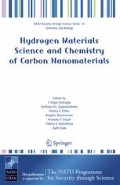Abstract
The structures of stable (i.e. produced, isolated and characterized) higher fullerenes have been analyzed. General rules governing the molecular structure of stable (extracted) higher fullerenes have been revealed. A number of fullerene substructures that have electronic features similar to their well known aromatic analogues have been identified. It has been shown, that the possibility of production of the isomers of higher fullerenes is defined by a position of the most energetically favorable isomer inside the suggested “beam of stability”, constructed according to the calculated data for stable fullerenes, that the molecules have closed shell.
Access this chapter
Tax calculation will be finalised at checkout
Purchases are for personal use only
Preview
Unable to display preview. Download preview PDF.
References
Khamatgalimov, A.R., Kovalenko, V.I. (2004) Endohedral higher metallofullerenes: structure and properties, Russ Chem Journ; 48(5), 28–36 (russian).
Chen, Z., Cioslowski, J., Rao, N., Moncrieff, D., Bühl, M., Hirsch, A., Thiel, W. (2001) Endohedral chemical shifts in higher fullerenes with 72–86 carbon atoms, Theor Chem Acc 106, 364–368.
Cioslowski J., Rao N., Moncrieff D. (2000) Standard Enthalpies of Formation of Fullerenes and Their Dependence on Structural Motifs, J Am Chem Soc 122, 8265–8270.
Chen, Z., Thiel, W. (2003) Performance of semiempirical methods in fullerene chemistry: relative energies and nucleus-independent chemical shifts, Chem Phys Lett 367, 15–25.
Kovalenko, V.I., Semyashova, M.V. (1999) φ-Bond Distribution of C60 and C70 and Some higher fullerenes. Abstracts, 4th biennial Workshop “Fullerenes and Atomic clusters” (IWFAC’99), 234.
Fowler, P.W., Manolopoulos, D.E. (1995) An Atlas of Fullerenes. Clarendon Press, Oxford.
Sun, G., Kertesz, M. (2001) Isomer Identification for Fullerene C84 by 13C NMR Spectrum: A Density-Functional Theory Study, J Phys Chem A 105, 5212–5220.
Author information
Authors and Affiliations
Editor information
Editors and Affiliations
Rights and permissions
Copyright information
© 2007 Springer
About this paper
Cite this paper
KOVALENKO, V., KHAMATGALIMOV, A. (2007). ELECTRONIC STRUCTURE AND STABILITY OF HIGHER FULLERENES. In: Veziroglu, T.N., et al. Hydrogen Materials Science and Chemistry of Carbon Nanomaterials. NATO Security through Science Series A: Chemistry and Biology. Springer, Dordrecht. https://doi.org/10.1007/978-1-4020-5514-0_54
Download citation
DOI: https://doi.org/10.1007/978-1-4020-5514-0_54
Publisher Name: Springer, Dordrecht
Print ISBN: 978-1-4020-5512-6
Online ISBN: 978-1-4020-5514-0
eBook Packages: Chemistry and Materials ScienceChemistry and Material Science (R0)

